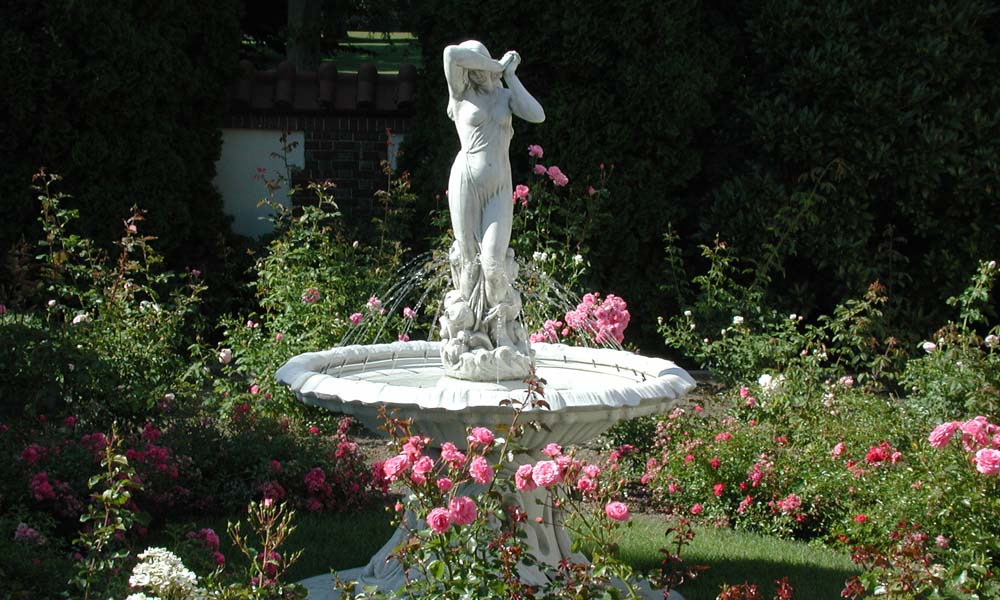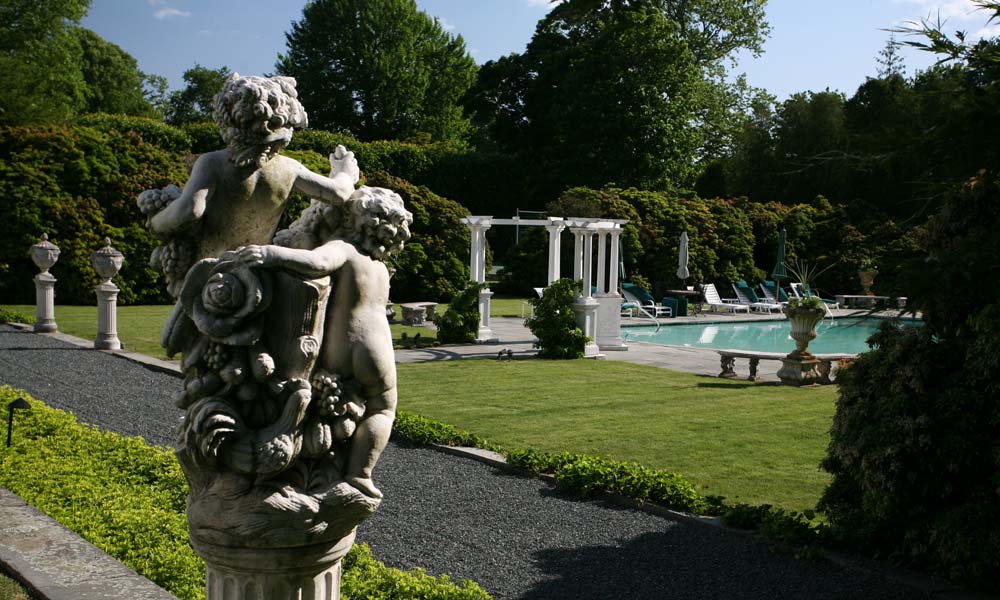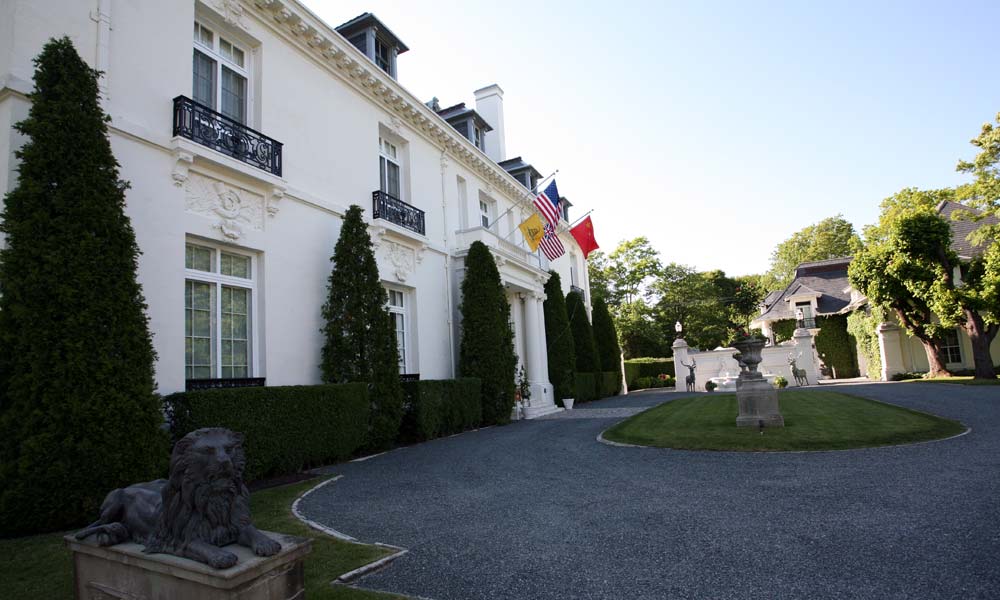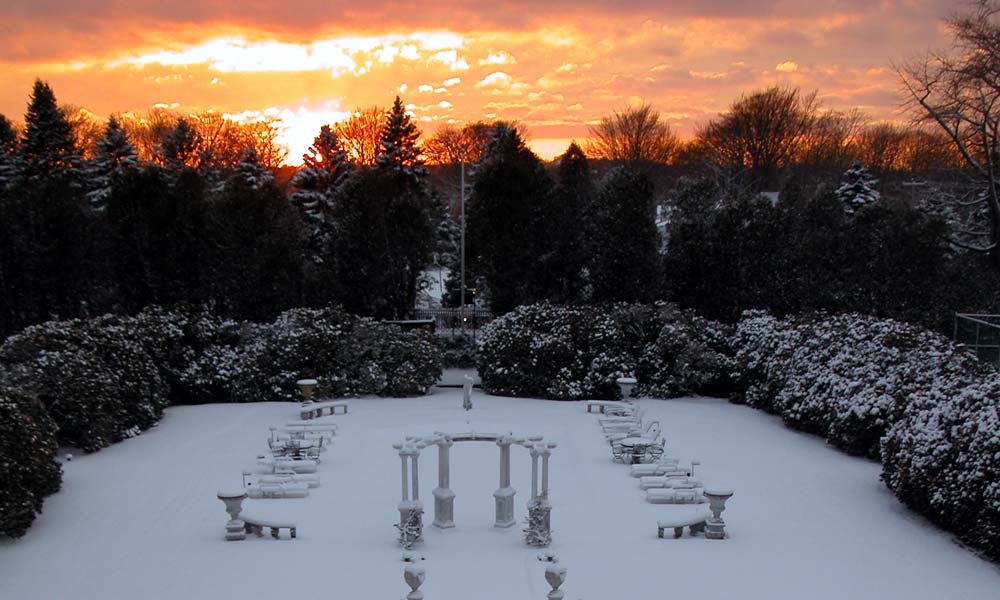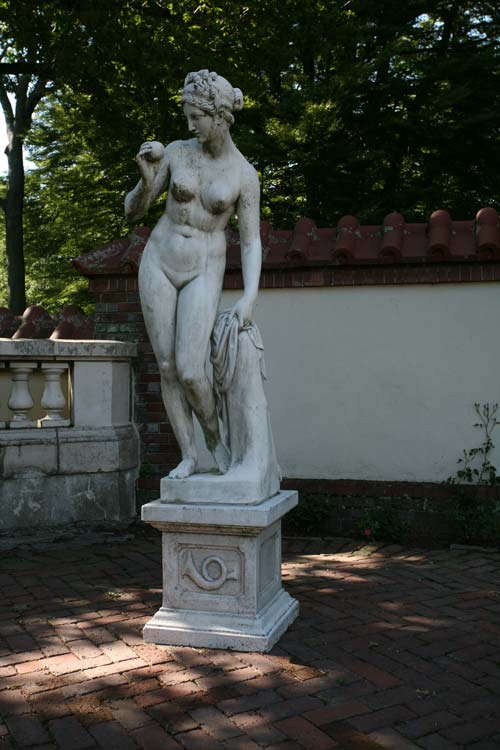
The art of the garden reached its height at the fin de siecle, when American tastes turned towards naturalistic plans as well as to their antithesis—historical revivalism. Adjacent to Vernon Court, Frederick Law Olmsted, the first American landscape architect, designed the three-acre grounds for the now demolished mansion, Stoneacre (1884). Olmsted contoured the topography from absolutely flat to include small swells to create a more naturalistic appearance than the property originally had. This contrasts greatly with Wadley & Smythe's formal, neoclassical-style (Renaissance Revival) gardens at Vernon Court.
Nature Perfected: Vernon Court Gardens
During the early decades of the 20th century, symmetrical gardens adorned with topiaries, fountains, ornaments, and sculpture were the pinnacle of fashion. At Vernon Court, the main axis of each salon and its vista is the room's center-line. This design concept, L’oeil du plan, means a proportionate balancing of the parts, tying together the entire site. The great drama of the Sunken Garden comes from the west façade addressing Bellevue Avenue, the formal building front, while the actual main Entrance Court is on the side of the property. Original sculptures have long since been removed or lost to neglect over the decades. Remaining consistent with the "Gilded Age" fashion, Museum Director Judy Goffman Cutler placed sculpture at critical points. Otherwise, the Gardens have remained primarily the same from 1898 until the 1980’s, when a previous owner replaced a central 40' circular fountain and reflecting pool with a swimming pool, and a bowling green and a croquet court with two tennis courts. The Gardens, however, are still very close to their original state; they are in fact, "nature perfected."
THE FORE COURT
The Fore Court, or Forward Court, begins at the Main Gates on Victoria Avenue and continues to the reclining lions (Patience and Fortitude) that guard the public entrance.
ROSE GARDEN
A well-enclosed compound, this privy garden is the most remote location on the property. A low Euonymus hedge creates a sense of further interior enclosure and demarcates a luxuriant array of rose bushes with a central fountain, La Vergogna Ostia.
FOUR HORSE GARDEN
Entering the West Garden House from the Fore Court, one encounters a brick walkway leading into a quiet private garden, with its central focus, Fontana dei Quattro Cavalli, after Giacomo Barozzi da Vignola's original, circa 1551.
MARBLE TERRACE
A broad Marble Terrace (30' wide by 110' long) with an adjacent flat grassy area, leads from the mansion to the majestic, equally wide, white marble stairs into the Sunken Garden.
SUNKEN GARDEN
Our Fernleaf Beech tree has been designated as a State Champion Tree of Rhode Island, and is one of the largest and oldest in the nation. It visually defines the side limits of an expansive, but nevertheless internalized garden view. The bordering parterre segments correspond to the width of the building and are bounded by a gargantuan U-shaped Andromeda Japonica, one of the largest of its species.
Stoneacre: Frederick Law Olmsted Park and Arboretum
Stoneacre, situated on three acres opposite Vernon Court between Ruggles Avenue and Victoria Avenue, was named for the mansion designed in 1884 by architect William Potter for John W. Ellis. Potter recommended Frederick Law Olmsted (1822-1903) to his client as “a garden designer.” Stoneacre became Olmsted’s first commission after he named the new profession “landscape architecture.” The Stoneacre mansion was demolished in 1963 and the grounds lay dormant for decades thereafter. It is the last privately held open space on Bellevue Avenue. Stoneacre was purchased along with Vernon Court in 1998 by Judy Goffman Cutler, where they created a memorial park honoring its designer, Frederick Law Olmsted, America’s first and most noted landscape architect.
Olmsted designed the nation's most beloved parks and grounds including: New York’s Central Park, The White House, Brooklyn’s Prospect Park, the 1893 Chicago World’s Fair, the Biltmore, Winterthur, Detroit’s Belle Isle, Boston’s Franklin Park, and many estate grounds. He conceived of Boston’s first park system known as The Emerald Necklace. Olmsted’s office went on to create the National Park System and designed a plethora of campus plans including Stanford University. Olmsted was a social activist and reformer, artist and engineer—a man of epic vision. His work during the thirty years following the Civil War created an American landscape that is enjoyed today and forevermore.
Olmsted conceived of Stoneacre as a “park-like setting” with a variety of exotic trees to protect the Ellis family from viewers. Stoneacre was furnished with native and exotic trees including London Plane, Fern Leaf Beech, Japanese Maple, Zelkova, European Linden, English Oak, and Tulip Trees, as well as Silver Maple, Cucumber, and Sweet Gums. Manmade earthen forms and contours were designed to give a rolling and more interesting perspective to the overall site, which had been flat prior to Olmsted’s naturalistic design.
Judy Goffman Cutler, founder of The National Museum of American Illustration at Vernon Court, honor Olmsted’s legacy with his design for a small private park as a perpetual memorial to America’s first landscape architect: The Frederick Law Olmsted Park and Arboretum.
The Frederick Law Olmsted Park and Arboretum was accredited in 2015 as a Level I Arboretum by the Moreton Register of Arboreta and the international ArbNet program.
A Tripartite Project for the Museum
The National Museum of American Illustration
the first national museum of illustration art
The Frederick Law Olmsted Park and Arboretum
the first national memorial to a landscape architect
The Louis Kahn Memorial Arch
the first national memorial to an architect
Vernon Court was designed by Carrère & Hastings, architects of the New York Public Library, The Frick Collection, The Flagler Museum in Palm Beach, Nemours (DuPont mansion museum in Wilmington), Neue Galerie in NYC, the United States Senate and House Office Buildings, and many other nationally recognized architectural monuments.
The adjacent Stoneacre grounds were designed by Frederick Law Olmsted in 1884, America's legendary first landscape architect, designer of Central Park, the White House grounds, the National Park System, many Newport estates, and enumerable other notable projects. The Frederick Law Olmsted Park and Vernon Court's grounds, designed by Wadley & Smythe, have a number of Champion Trees of the USA, including Ginkgo, Japanese Zelkova, Fernleaf Beech and Yeddo Spruce. A Memorial Arch in honor of Louis I. Kahn, the greatest American architect of the second half of the 20th century, will be constructed in the future. This unique tripartite project comprises a great step forward towards protecting and enhancing our nation's architectural and artistic heritage.
Vernon Court combines art from the "Golden Age of American Illustration" in "Gilded Age" architecture. It is truly an alliance of art and architecture, rarely achieved and unique. Other comparable institutions are the Isabella Stewart Gardner Museum in Boston, Albert Barnes Foundation in Pennsylvania, Borghese Gallery in Rome, Kenwood English Heritage and The Wallace Collection in London.
The National Arts Club was the founding institution for the Museum, which is a private undertaking of The American Civilization Foundation, a nonprofit organization.


